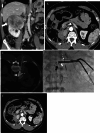Beyond the Scalpel: the Role of Image-Guided Thermal Ablation in Management of Metastatic Renal Cell Carcinoma in the Era of Immunotherapy
- PMID: 40555768
- PMCID: PMC12325399
- DOI: 10.1007/s00270-025-04101-y
Beyond the Scalpel: the Role of Image-Guided Thermal Ablation in Management of Metastatic Renal Cell Carcinoma in the Era of Immunotherapy
Abstract
Renal cell carcinoma (RCC) is the most common type of kidney cancer and accounts for approximately 90% of all renal malignancies. About 30% of patients have metastatic disease at their initial presentation. Historically, these patients have very poor prognosis with a median survival of 12 months. The recent introduction of immune checkpoint inhibitors (ICI)-based immunotherapy, which disrupts cancer-induced immune tolerance and promotes immune-mediated cancer cell killing, has significantly improved patient outcome. While ICI-based therapy represents the standard of care for metastatic RCC, there are significant treatment-related adverse effects. This review article will examine how image-guided ablation, as an adjunct to immunotherapy, can improve survival and quality of life in patients with metastatic RCC.
Keywords: Cryoablation; Immunotherapy; Metastasis; Renal cell carcinoma; Thermal Ablation.
© 2025. The Author(s).
Figures



Similar articles
-
Immune checkpoint inhibitor therapy in metastatic renal cell carcinoma: tumour response and immune-related renal vasculitis following cytoreductive nephrectomy.Pathologica. 2025 Jun;117(3):249-257. doi: 10.32074/1591-951X-N998. Epub 2025 Jun 6. Pathologica. 2025. PMID: 40474803 Free PMC article.
-
Immune Checkpoint Inhibitor Therapy Before Nephrectomy for Locally Advanced and Metastatic Renal Cell Carcinoma: A Review.JAMA Oncol. 2024 Feb 1;10(2):240-248. doi: 10.1001/jamaoncol.2023.5269. JAMA Oncol. 2024. PMID: 38095885 Review.
-
Immunotherapy for metastatic renal cell carcinoma.Cochrane Database Syst Rev. 2017 May 15;5(5):CD011673. doi: 10.1002/14651858.CD011673.pub2. Cochrane Database Syst Rev. 2017. PMID: 28504837 Free PMC article.
-
Cytoreductive nephrectomy in metastatic renal cell carcinoma.Cochrane Database Syst Rev. 2024 Jun 7;6(6):CD013773. doi: 10.1002/14651858.CD013773.pub2. Cochrane Database Syst Rev. 2024. PMID: 38847285 Free PMC article.
-
Systemic treatments for metastatic cutaneous melanoma.Cochrane Database Syst Rev. 2018 Feb 6;2(2):CD011123. doi: 10.1002/14651858.CD011123.pub2. Cochrane Database Syst Rev. 2018. PMID: 29405038 Free PMC article.
References
-
- Ljungberg B, Albiges L, Abu-Ghanem Y, Bedke J, Capitanio U, Dabestani S, et al. European association of urology guidelines on renal cell carcinoma: The 2022 update. Eur Urol. 2022;82:399–410. - PubMed
-
- Ferlay J, Colombet M, Soerjomataram I, Dyba T, Randi G, Bettio M, et al. Cancer incidence and mortality patterns in Europe: estimates for 40 countries and 25 major cancers in 2018. Eur J Cancer. 2018;103:356–87. - PubMed
-
- Tran J, Ornstein MC. Clinical review on the management of metastatic renal cell carcinoma. JCO Oncol Pract. 2022;18:187–96. - PubMed
-
- Dudani S, de Velasco G, Wells C, Gan CL, Donskov F, Porta C, et al. Sites of metastasis and survival in metastatic renal cell carcinoma (mRCC): Results from the International mRCC database consortium (IMDC). JCO. 2020;38:642–642.
-
- Medical Research Council Renal Cancer Collaborators. Interferon-α and survival in metastatic renal carcinoma: early results of a randomised controlled trial. The Lancet. 1999;353:14–7. - PubMed
Publication types
MeSH terms
Substances
LinkOut - more resources
Full Text Sources
Medical

